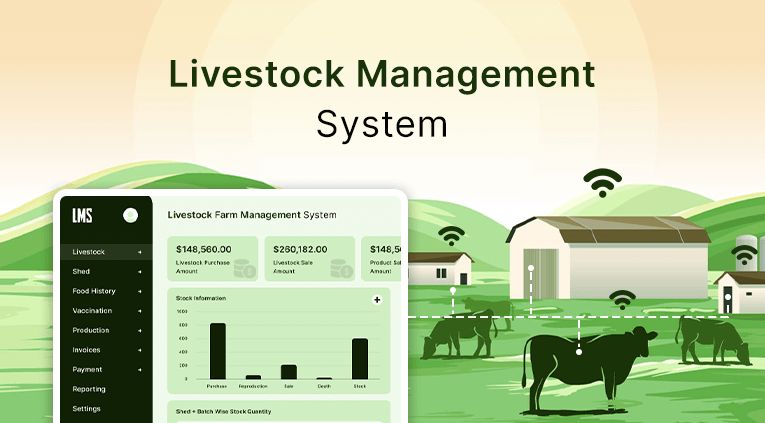Software development has spurred business objectives since technology took its place. Businesses began to realize that software can create an altogether new space to interact with other stakeholders. There are many ways for a developer to choose a particular path. But it’s also important to know the basics for the one who just wants the end product, i.e., software.
People usually are now ambiguous about selecting between waterfall vs agile. The developmental methodologies, specifically a way of organizing the process of software development. These are the most popular ones with a usable and mature methodology. This guide will help you to understand these two and decide which one is better for you.
Statistics
Before going into the subjective part, let’s get to know the facts and researched surveys agile and waterfall.
According to Ambysoft’s Survey, the agile method is 64% successful while the waterfall has a 48% of success rate. The prior has a failure rate of 8% and the latter one has 18%.
Capterra concludes that 71% of companies are now implementing Agile. Harvard business review states that 60% of companies experience revenue growth and profits after incurring the Agile approach.
Understanding Agile Methodology
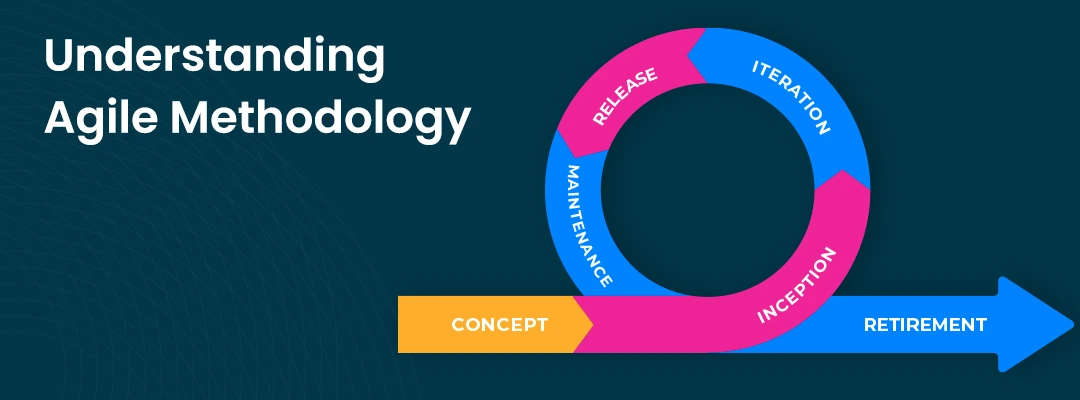
The Agile methodology is an iterative process of managing projects. The agile model phases break up into several various phases, involving constant collaboration with stakeholders. It manages continuous improvement at every stage.
There Are Six Parts Of The Agile Model Stages:
- Concept
- Inception
- Iteration
- Release
- Maintenance
- Retirement
Further, the Agile iteration usually takes two to four weeks with an end date. The workflow of Agile iteration typically flows into five steps. Plan Requirements, Develop products, Test software, deliver iteration, and incorporate feedback. Each stage mentioned above has several iterations.
Characteristics of the Agile Methodology
After getting to know the meaning of Agile Methodology, here is a list of characteristics that make Agile distinctive.
- Before launching the product officially, the team scans the software for changes according to minimum requirements. The step is called MVP(Minimum Viable Product), this is tried by the customer by giving feedback.
- The development is in various phases, also known as an iterative process rather than one linear sequence.
- The teams using the Agile framework focus on the deliverable value that is tangible to be measured and also check the feedback regularly.
- Unlike many other methods, Agile allows the teams to have cross-functions with the maximum possible interactions between them and with customers.
- An agile team has its focus only on what’s needed to be delivered.
Reasons to Use Agile Methodology
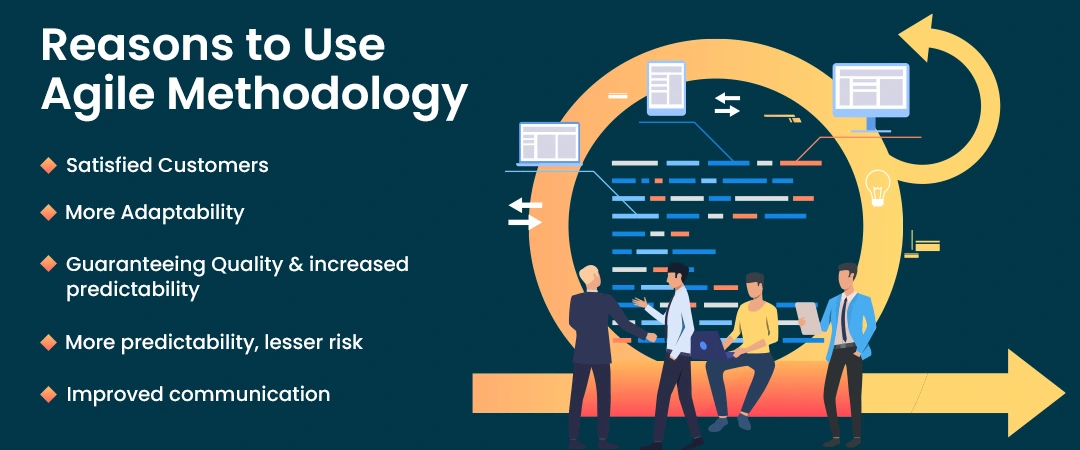
The Agile Diagram follows a new era framework, with rapid technological advances. There are various reasons why companies widely use the Agile Method and why one should adopt it. This is the list of reasons or advantages of Agile methodology.
Satisfied Customers:
As we have seen, Agile involves the customers in its developmental process. Without assuming what users want, the Agile method understands how their demands can be met. This method values the opinions and ensures that the final product is what they need.
Agile results in tailor-made software delivery, which is likely to increase user interface and hence boost customer retention.
More Adaptability:
Due to its iterative process, the central theme of Agile is flexibility. The teams using this method are responsive to change and modifications, as its process allows the changes to be incurred without any disruption.
Nothing is rigid, the priorities and delivery can be adjusted without any chaos. More adaptability, suggests that the team can deliver accountability and manage clients’ changing demands.
Guaranteeing Quality and Increased Predictability:
Using an iterative process for managing the projects allows for improving the quality at every step. Consistent focus on improvement and quality management is the fundamental principle of Agile.
Agile teams work in a sprint, meaning a short period with a fixed duration. This process makes it easier to predict the outcome. Also, estimating costs is easier and more efficient.
More Predictability, Lesser Risk:
Assessing the progress during sprints creates better visibility into the projects. Regular checking can help with spotting potential obstacles and tackling minor issues. It also facilitates effective risk management and gives the process a greater chance of software success.
Improved Communication:
Agile teams prioritize regular interaction with more face-to-face communication. Teams usually conduct daily meetings to ensure and check everyone’s progress. Through regular communication, they cease any type of confusion to successfully achieve their objectives.
Better communication helps in having a singular approach for the team and better teamwork invites better project delivery.
Possible Fallbacks of Agile Methodology
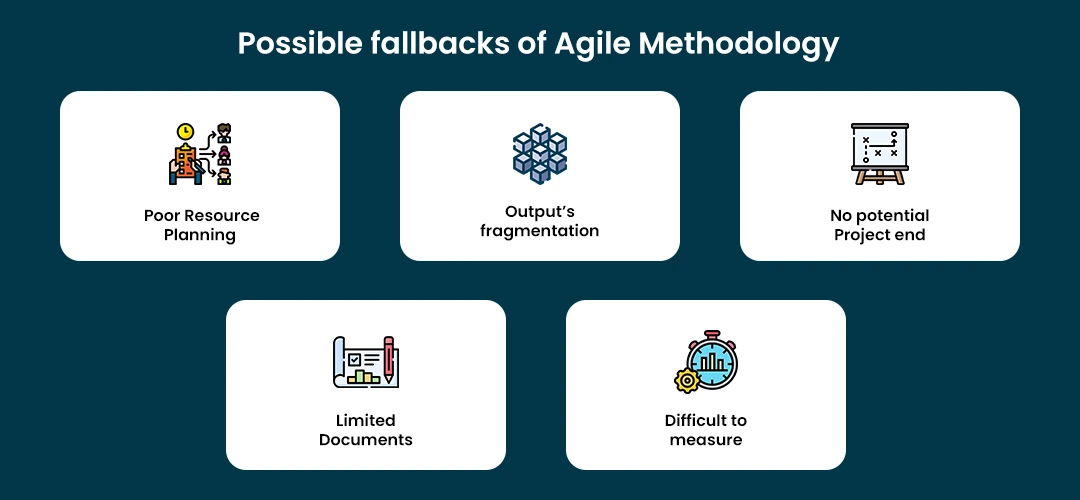
Understanding both Agile Advantages and Disadvantages is important. Being aware of possible fallbacks helps you in eliminating them while practicing the process.
Poor Resource Planning:
With Agile it is difficult to predict required costs, time, and resources because the teams don’t know when and how it will end. With consistent openness to changes, the teams won’t have any idea of their result.
Output’s Fragmentation:
Incremental delivery is one of the basic features of agile methodology. However, it helps to bring success in the market easily but also fragments the output due to different cycles. If not careful enough this can be a huge disadvantage of using Agile.
No Potential Project End:
Agile requires minimal planning at the start as it allows modifications in between the process. Although, this minimal planning results in an unclear picture of the final product and can incur unexpected functionality.
Limited Documents:
The agile method is less detailed as the documentation happens throughout the project rather than at the beginning.
Difficult To Measure:
The tracking process is about looking across cycles, a “see-as-you-go” nature. This means that one can not set many KPIs at the start of the project. This iterative process makes its measurement difficult.
Understanding Waterfall Methodology
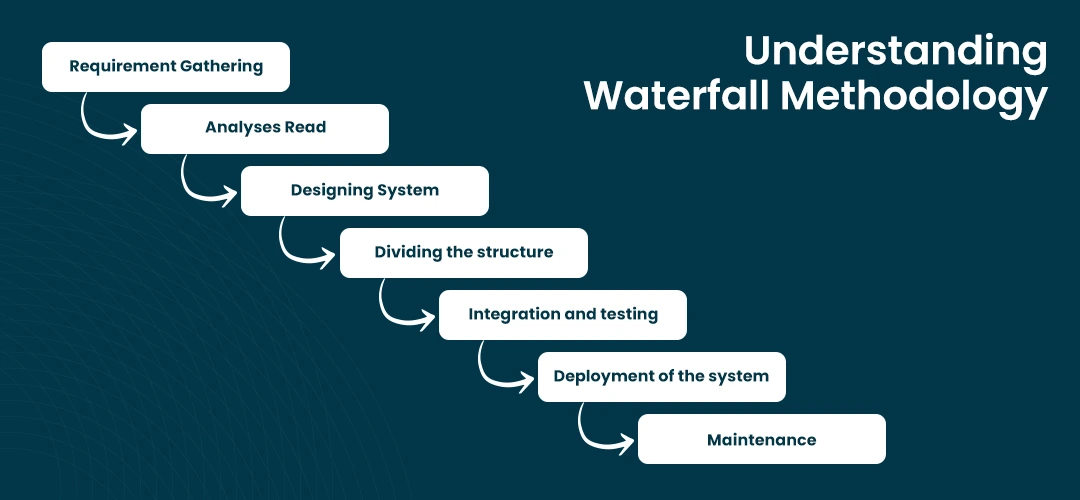
This one is the classic model used for system development to create a system with a linear and sequential approach. As the term suggests, the model develops systematically going from one phase to another with a downward flow.
Unlike Agile, this model employs a planned process. The Waterfall model phases are divided into different phases such as the output of one phase being used as input for the next phase. It requires that every phase should be completed before another phase, to avoid overlapping many phases together.
The Waterfall Model Diagram Works In Sequential Phases Of 7 Levels. These Levels Are: –
Requirement Gathering: All the required resources and demands are documented clearly at the time of planning.
Analyses Read: To define the schemas, models, and business rules, the listed requirements are analyzed carefully.
Designing System: Waterfall makes the team design the software architecture based on analyzed requirements.
Dividing The Structure: Implementing, developing, and planning the software in small units with functional testing is part of the waterfall methodology.
Integration And Testing: Integration here means creating a link between each unit of development with the previous phase. And when the integration is done, there is a test conducted for reviewing the whole planned test.
Deployment Of The System: This step is about making the product live in production environments with all the planned steps after functional and non-functional testing is completed.
Maintenance: The final step is about fixing the issues and modifying the possible issues before implementation.
Why is the Waterfall Method a Good Choice?
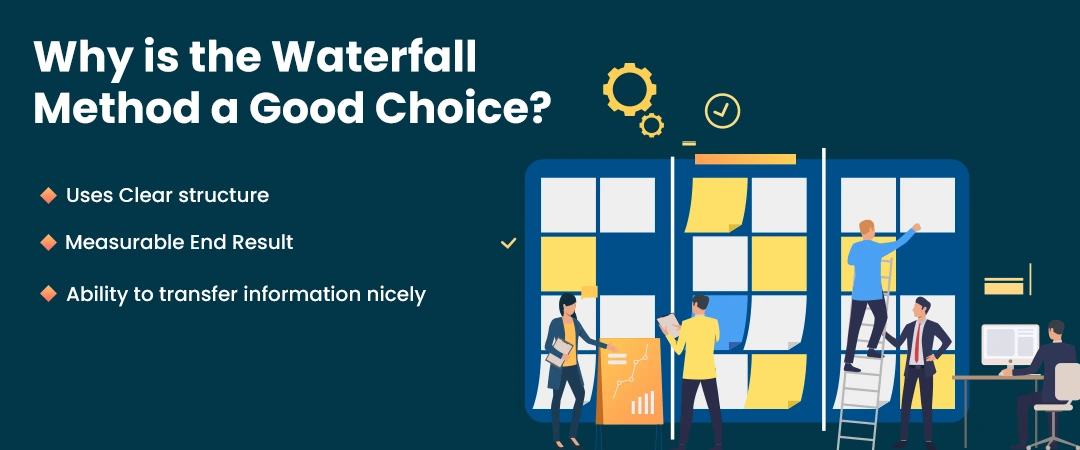
Releasing on a particular sequence of steps, with a phase initializing another phase, this structure proves itself to be the best choice for smaller projects. This section gives you an in-depth insight into why this methodology does the best.
Uses Clear Structure:
Unlike Agile methodology, waterfall focuses on a clear and defined set of steps. Teams must complete an entire step before moving to another one. This clear sequence eliminates any type of blocks and half-finished assigned months are likely to be sidelined. Also, a clear vision means intuitive project delivery.
Measurable End Result:
With proper planning, Waterfall allows the team to have a predictable end goal and greater commitment. For small projects clear goals from the beginning are good. Waterfall keeps the focus on the end goal with a concrete plan.
Ability To Transfer Information Nicely:
The waterfall is planned in detail. This method invites a clear transfer of information at each step. Each team for each phase has access to prior information.
Disadvantages Of Employing Waterfall Methodology

The waterfall method has recently faced much criticism because of its rigid nature. It makes it outdated for contemporary technological demands. These limitations are what you can expect if you choose to go for a waterfall development process.
Modifications Are Difficult:
With an entirely traditional form, this method is with no room for unexpected changes or modifications. This one is the most expected limitation of the waterfall. For small projects, the waterfall can be a good choice but larger projects need to be modified regularly.
Doesn’t Involve The End-user:
One of the worst fallbacks of the waterfall is that it eliminates the opinions of the end-user. The main objective is to help internal teams to move from one phase to another easily but avoid external factors. This can lead to lesser user satisfaction.
Delays The Testing After Completion:
Unlike Agile, in the waterfall, the testing and feedback are done after the software is developed. This can make the procedure clear but also makes the required modifications chaotic.
Analyzing Agile vs Waterfall
As we have comprehended the basics of Agile and Waterfall, let’s now create a sense of their comparison.
The first step to comparing the Agile vs Waterfall model is to understand when it can be used. For example, when one requires a high-priority core enterprise like a system of records, this system won’t require frequent changes. On the other side systems like accounting demand modifications. The level of frequency of required modifications differs in the areas in which these two methods can be used.
The second step is the core difference of their approach. The agile vs Waterfall approach works with the understanding that one is an iterative process and the other is a linear approach. Taking into consideration the agile framework, it includes gathering, designing, developing, testing, and reviewing. The application software development is done with incremental changes.
It can be different from a waterfall in the way that waterfall’s requirements are baselined. The functional product is delivered in every phase after which another starts.
The Agile vs Waterfall analogy also differs in the degree of flexibility offered. The project’s requirements decide the level of flexibility it wants. As Agile offers more flexibility it is good for large projects and waterfall is suitable for smaller ones.
Further, they differ because of the types of teams working on it. The agile project works with a cross-functional team. There are interchangeable duties with great teamwork. On the other hand, Waterfall’s teams have people with different functional skills working together.
The Takeaway Note
Waterfall and Agile are the most popularly used software development methodologies. The requirements of the project determine which can be better and more suitable. Both of these methods work with different approaches, structures, and architecture. This guide will assist you in determining which one is better for you.
Experts can help with any of these methods. However, if you know the basics it can be easier for you to determine the better option.
Auxano Global Services¸ the top bespoke app development agency works best with both methodologies. We here believe that requirements determine which method can be used. Our experts excel in any type of method. Aligning years of experience with newness in skills, the professionals work here with utter adeptness. Work with us, Consult the experts to know the best way, and hire the filtered group of professionals.
If you wish to develop your software through these methods, contact us now.
Frequently Asked Questions
-
1. In which aspects do determine a better option from waterfall and agile depend?
The project’s requirement for flexibility, duration of the process, engagement of end-user, level of complexity, and scale of the project determines the better option.
-
2. What is the cost of Waterfall Project management?
The cost of the Waterfall project depends on the number of phases required. More steps, the higher the cost. You can consult us to know more about the charges.
-
3. How much does it cost to develop software through the Agile Model?
Like Waterfall, it depends, but here we can provide the tentative charge. Expect the rate to be from $230 000 to $300 000.
-
4. Is it better to hire an agency than employ freelancers for any of these methods?
These methods require a team working on them. More than freelancing an agency can deliver because the latter has a professional team that can utilize any of these methods in a better way.
-
5. What is the best IT agency to go with?
Auxano Global Services is the best IT agency you can hire with professionals practiced to work for any required method. Consult us for any method you want or choose the most suitable one.




